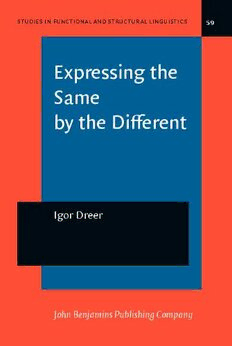
Expressing the Same by the Different: The Subjunctive vs the Indicative in French PDF
Preview Expressing the Same by the Different: The Subjunctive vs the Indicative in French
Expressing the Same by the Different Studies in Functional and Structural Linguistics (SFSL) Taking the broadest and most general definitions of the terms functional and structural, this series aims to present linguistic and interdisciplinary research that relates language structure — at any level of analysis from phonology to discourse — to broader functional considerations, whether cognitive, communicative, pragmatic or sociocultural. Preference will be given to studies that focus on data from actual discourse, whether speech, writing or other nonvocal medium. The series was formerly known as Linguistic & Literary Studies in Eastern Europe (LLSEE). Founding Editor Honorary Editors John Odmark Eva Hajičová Petr Sgall Charles University Charles University General Editors Yishai Tobin Ellen Contini-Morava Ben-Gurion University of the Negev University of Virginia Editorial Board Alexandra Y. Aikhenvald Jim Miller La Trobe University University of Auckland Joan Bybee Marianne Mithun University of New Mexico University of California, at Santa Barbara Nicholas Evans Lawrence J. Raphael University of Melbourne CUNY and Adelphi University Victor A. Friedman Olga Mišeska Tomić University of Chicago Leiden University Anatoly Liberman Olga T. Yokoyama University of Minnesota UCLA James A. Matisoff University of California, Berkeley Volume 59 Expressing the Same by the Different. The subjunctive vs the indicative in French Igor Dreer Expressing the Same by the Different The subjunctive vs the indicative in French Igor Dreer Ben-Gurion University of the Negev Petr Sgall Charles University John Benjamins Publishing Company Amsterdam / Philadelphia TM The paper used in this publication meets the minimum requirements of 8 American National Standard for Information Sciences – Permanence of Paper for Printed Library Materials, ansi z39.48-1984. Library of Congress Cataloging-in-Publication Data Dreer, Igor. Expressing the same by the different : the subjunctive vs the indicative in French / Igor Dreer. p. cm. (Studies in Functional and Structural Linguistics, issn 0165-7712 ; v. 59) Includes bibliographical references and index. 1. French language--Mood. 2. French language--Subjunctive. I. Title. PC2290.D74 2007 445'.6--dc22 2007022856 isbn 978 90 272 1568 0 (Hb; alk. paper) © 2007 – John Benjamins B.V. No part of this book may be reproduced in any form, by print, photoprint, microfilm, or any other means, without written permission from the publisher. John Benjamins Publishing Co. · P.O. Box 36224 · 1020 me Amsterdam · The Netherlands John Benjamins North America · P.O. Box 27519 · Philadelphia pa 19118-0519 · usa Dedication To my wife Marina for all her support and encouragement, for her belief in me, without which this book would not appear. Table of contents Acknowledgements xi List of tables xiii List of figures xv Preface xvii 1. Theoretical background xvii 1.1 The inadequacy of functions, attributed to each mood xvii 1.2 The inadequacy of the government of French mood xxi 2. A systematic approach xxv Part 1. The problem of French mood chapter 1 Sentence-oriented approaches 3 1.1 Syntactic approach 4 1.2 Generative approach 9 1.3 Functional approach 13 1.4 The functional approach of Martinet 23 1.5 Cognitive approach 26 1.6 Psycho-semantic approach 32 1.7 Logico-pragmatic approach 37 chapter 2 Sign-oriented approaches 43 2.1 Jakobsonian-van Schooneveldian theory 44 2.2 Guillaumean theory 47 2.3 Summary and conclusions 48 Part 2. Columbia School theory chapter 3 The basic principles 55 3.1 The Columbia School definition of language 55 3.2 Invariant meaning versus contextual messages 57 viii Expressing the Same by the Different 3.3 Meanings and signals in Columbia School theory 60 3.4 Relationships between signs in Columbia School theory 62 3.5 The communicative and human factors in Columbia School theory 65 3.6 Communicative strategies in Columbia School theory 69 3.7 Summary of the Columbia School principles 72 chapter 4 Hypothesis 75 4.1 The Occurrence System 75 4.2 Invariant meaning versus contextual messages 77 4.3 Meaningful contrast between the Subjunctive and the Indicative 78 4.4 Summary and conclusions 80 Part 3. “Micro-level” analysis chapter 5 Occurrence System and the encoder’s commitment 85 5.1 The certainty versus the uncertainty of an occurrence 86 5.2 Personalized versus depersonalized occurrences 113 5.3 The degree of the encoder’s attention, concentrated on the subject 121 chapter 6 Occurrence System and subjective comment 129 6.1 Explicit comments 130 6.2 Implicit comments 136 chapter 7 Occurrence System and negation 147 7.1 Explicit negation 148 7.2 Implicit negation 153 7.3 The uniqueness of an occurrence 159 7.4 Summary and conclusions 163 Part 4. “Macro-level” analysis chapter 8 “From sign to text” approach 167 8.1 Le Malentendu (The Misunderstanding) 168 8.2 Le revolver de Maigret 174 Table of contents ix chapter 9 “From text to sign” approach 181 9.1 Antigone 182 9.2 L’insoutenable légèreté de l’être (The Unbearable Lightness of Being) 188 9.3 Summary and conclusions 196 Part 5. The Subjunctive moods: Diachronic analysis chapter 10 Previous explanations for the use of the Subjunctive forms and for their disfavoring 201 10.1 Sentence-oriented explanations 201 10.2 Sign-oriented explanation 205 chapter 11 The analysis of the general disfavoring of the Subjunctive 207 11.1 The losses of the Contemporary French Subjunctive 208 11.2 The loss of the Old French Subjunctive 213 chapter 12 The analysis of the disfavoring of the Imperfect Subjunctive 217 chapter 13 The Subjunctive moods in Old French: “Micro-level” analysis 223 13.1 The System of Relevance and the encoder’s concern 223 13.2 The System of Relevance and the possibility of an occurrence 227 chapter 14 The Subjunctive moods in Old French: “Macro-level” analysis 231 chapter 15 The Subjunctive moods in Contemporary French: “Micro-level” analysis 239 15.1 The System of Relevance and the encoder’s concern 239 15.2 The System of Relevance and the possibility of an alternative 244 chapter 16 The Subjunctive moods in Contemporary French: “Macro-level” analysis 249 16.1 Les jeunes filles (The Girls) 249
